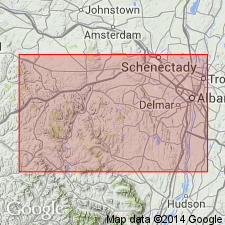
- Usage in publication:
-
- Becraft limestone
- Modifications:
-
- Original reference
- Dominant lithology:
-
- Limestone
- AAPG geologic province:
-
- Appalachian basin
- New England province
Summary:
Pg. 9-13. Upper PENTAMERUS limestone or SCUTELLA (Becraft) limestone underlies Oriskany sandstone and overlies Shaly limestone in Schoharie and Albany Counties, eastern New York. Top formation of Lower Helderberg.
[Named from Becraft's Mountain (Becraft Hills, Hudson South 7.5-min quadrangle), Columbia Co., eastern NY.]
Source: US geologic names lexicon (USGS Bull. 896, p. 142).
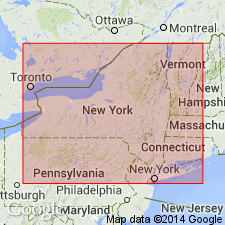
- Usage in publication:
-
- Becraft limestone
- Modifications:
-
- Principal reference
- Dominant lithology:
-
- Limestone
- AAPG geologic province:
-
- Appalachian basin
Summary:
Pg. 393-505. Becraft limestone. Pure, semicrystalline, massive, very fossiliferous limestone, 0 to 60 or more feet thick. Formerly called SCUTELLA or upper PENTAMERUS beds. Underlies Upper Shaly [Port Ewen] limestone and overlies Lower Shaly [New Scotland] beds. [Age is Early Devonian].
The geographic name, suggested by Dr. Hall, is from Becraft's Mountain [Becraft Hills, Hudson South 7.5-min quadrangle], Columbia Co., eastern NY.
Source: US geologic names lexicon (USGS Bull. 896, p. 142).

- Usage in publication:
-
- Becraft limestone*
- Modifications:
-
- Overview
- AAPG geologic province:
-
- Appalachian basin
Summary:
Becraft limestone. Recognized in eastern New York and Pennsylvania, western Maryland and Virginia, and northern West Virginia. Was for many years considered top formation of Helderberg group, but in eastern New York to younger formations (Port Ewen limestone (restricted) and Alsen limestone) are now included in the Helderberg. (See Winifred Goldring, 1931, New York State Mus. Hdbk., no. 10, p. 370, 376-379.) Age is Early Devonian.
Source: US geologic names lexicon (USGS Bull. 896, p. 142).
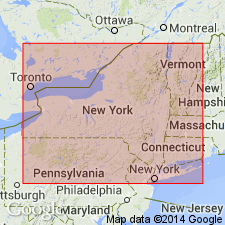
- Usage in publication:
-
- Becraft limestone
- Modifications:
-
- Areal extent
- AAPG geologic province:
-
- Appalachian basin
Summary:
Pg. 190, 370, 377. Becraft limestone of Helderberg group. Underlies Alsen limestone (new) of Helderberg. [Age is Early Devonian.]
Source: US geologic names lexicon (USGS Bull. 1200, p. 265-266).
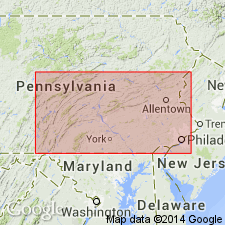
- Usage in publication:
-
- Becraft limestone
- Modifications:
-
- Areal extent
- AAPG geologic province:
-
- Appalachian basin
Summary:
Pg. 62-65. Becraft limestone. At Becraft Mountain, opposite Catskill, New York, New Scotland beds are overlain by Becraft limestone, 45 feet thick and consisting of light-gray crystalline in part crinoidal beds. Above Becraft are 25 feet of Alsen limestone. Becraft continues southward to Kingston, where it is 35 feet thick, and into New Jersey, where it is 15 to 20 feet thick. Alsen beds disappear southward and are displaced by Port Ewen beds. In Pennsylvania, Becraft and Port Ewen occur as units to which these names can be applied only in eastern part of Monroe County. Mandata shale and Licking Creek limestone of central and south-central Pennsylvania are partially of these ages. [Age is Early Devonian.]
Source: US geologic names lexicon (USGS Bull. 1200, p. 265-266).
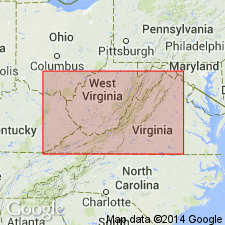
- Usage in publication:
-
- Becraft limestone member
- Modifications:
-
- Revised
- AAPG geologic province:
-
- Appalachian basin
Summary:
Pg. 279-286. Becraft limestone member of Helderberg limestone. Referred to as member of Helderberg in Virginia and West Virginia. In Virginia, the Becraft is generally bounded by New Scotland limestone but, in places perhaps, by Tonoloway limestone where rest of Helderberg is absent. Bounded above by either Oriskany sandstone or Onondaga formation, as the sequence varies from place to place. Has 2 distinct facies --pure limestone in its northern area and predominantly pure sandstone in its southwestern area; [applied names Becraft limestone, Becraft sandstone, and Becraft formation in text]. Thickness about 50 feet to about 100 feet. [Age is Early Devonian.]
Source: US geologic names lexicon (USGS Bull. 1200, p. 265-266).
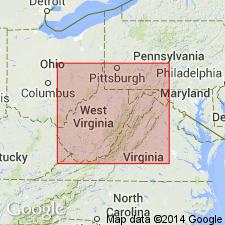
- Usage in publication:
-
- Becraft limestone
- Modifications:
-
- Areal extent
- AAPG geologic province:
-
- Appalachian basin
Summary:
Pg. 95-97. Becraft limestone. In most previous reports dealing with Helderberg group in the Virginias, a so-called Becraft limestone has been recognized and described. It is now believed, on evidence presented by F.M. Swartz, that the horizon so identified lies at a higher level than the true Becraft in New York. According to this interpretation, whatever representation the true Becraft has in West Virginia must come below cherty beds of Port Ewen (previously called, in part "Shriver" chert) and above cherty beds of New Scotland. This interval is occupied by soft gray calcareous shale that contains late New Scotland fauna with sparse forms of probable Becraft affinity.
[Misprint (US geologic names lexicon, USGS Bull. 1200, p. 266): date of publication is 1943, not 1948.]
Source: US geologic names lexicon (USGS Bull. 1200, p. 265-266).
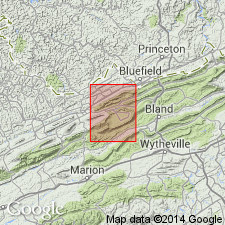
- Usage in publication:
-
- Becraft limestone
- Modifications:
-
- Not used
- AAPG geologic province:
-
- Appalachian basin
Summary:
Pg. 126. Swartz (1929) named Rocky Gap sandstone from Rocky Gap, Bland County, [southwestern Virginia]. Butts (1940) used name Becraft for this sandstone throughout southwestern Virginia; this use should be abandoned, and term Rocky Gap continued.
Source: US geologic names lexicon (USGS Bull. 1200, p. 265-266).
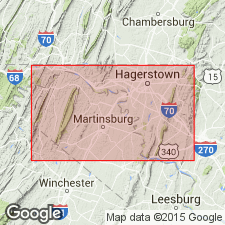
- Usage in publication:
-
- Becraft member
- Modifications:
-
- Areal extent
Summary:
In Maryland, Becraft member of Helderberg is an arenaceous limestone interbedded with black chert. Present only in Washington County where it is 85 feet thick. In Cumberland and Keyser sections, member is missing, but it continues into Virginia where it was described by Butts (1940). Overlies New Scotland member. [Age is Early Devonian.]
Source: US geologic names lexicon (USGS Bull. 1200, p. 265-266).
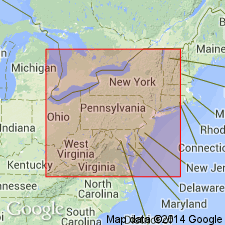
- Usage in publication:
-
- Becraft Formation
- Modifications:
-
- Areal extent
- AAPG geologic province:
-
- Appalachian basin
Summary:
Throughout most of the Hudson River Valley region, Becraft Formation conformably and gradationally overlies the Lower Devonian New Scotland Formation. In western part of outcrop belt, unit conformably and gradationally overlies the Lower Devonian Kalkberg. Conformably and gradationally underlies the Alsen Formation, or unconformably underlies the Oriskany Sandstone or other Deerparkian units. Becraft crops out as part of a narrow, tightly folded and faulted belt of rocks from Kingston, in Ulster Co., to Ravena, in Albany Co. Westward into Schoharie Co., faulting and folding die out. Becraft crops out in only two places on the east side of the Hudson River--at Becraft Mountain and at Mount Ida. Though several workers have tried to extend Becraft correlations to other regions of the Eastern U.S., these extensions have not been accepted by all. Present study indicates that Becraft was strongly affected by deep-burial diagenesis (3.2 to 6.5 km) following subaerial exposure. Texture varies widely. Locally hand specimens have gneissic texture and in thin section resemble marble.
Source: GNU records (USGS DDS-6; Reston GNULEX).
For more information, please contact Nancy Stamm, Geologic Names Committee Secretary.
Asterisk (*) indicates published by U.S. Geological Survey authors.
"No current usage" (†) implies that a name has been abandoned or has fallen into disuse. Former usage and, if known, replacement name given in parentheses ( ).
Slash (/) indicates name conflicts with nomenclatural guidelines (CSN, 1933; ACSN, 1961, 1970; NACSN, 1983, 2005, 2021). May be explained within brackets ([ ]).

